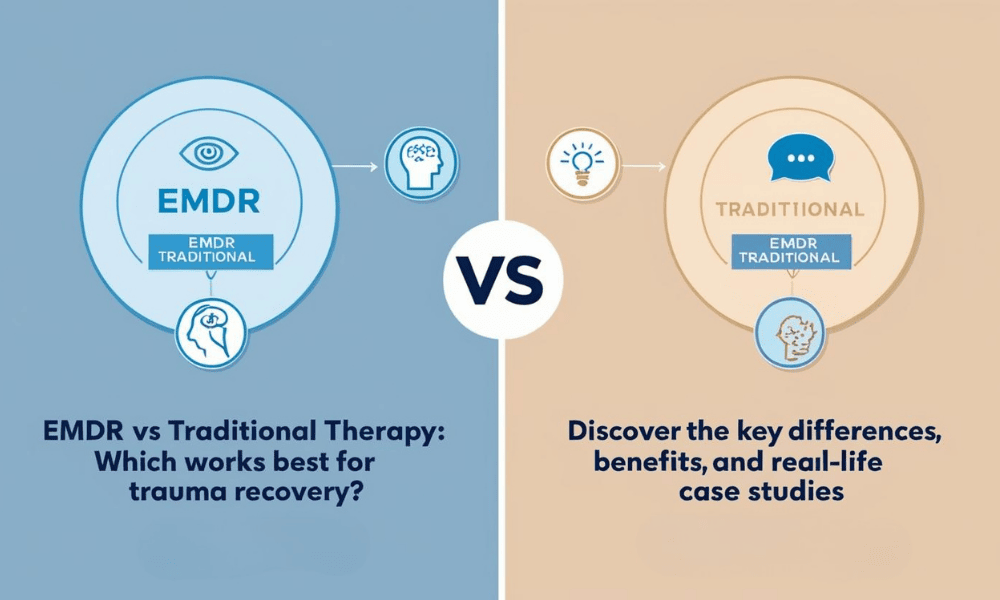Introduction
Trauma recovery is a complex process that varies for every individual. Two of the most widely used therapeutic approaches for treating trauma-related conditions like PTSD, anxiety, and depression are Eye Movement Desensitization and Reprocessing (EMDR) therapy and traditional talk therapy (such as Cognitive Behavioral Therapy (CBT) or Psychodynamic Therapy). But which method is more effective?
In this in-depth comparison, we will explore the key differences between EMDR and traditional therapy, analyze scientific evidence, provide expert insights, and present real-life case studies to determine which therapy works best for trauma recovery.
Understanding EMDR Therapy
What is EMDR Therapy?
Eye Movement Desensitization and Reprocessing (EMDR) is a structured psychotherapy approach specifically designed to help individuals process and heal from trauma. Developed by psychologist Dr. Francine Shapiro in the late 1980s, EMDR therapy near me focuses on changing how traumatic memories are stored in the brain through a combination of bilateral stimulation (eye movements, tapping, or auditory cues) and guided recall.
How EMDR Works
EMDR therapy consists of eight structured phases:
- History Taking & Treatment Planning – Identifying traumatic experiences and setting therapy goals.
- Preparation – Educating the patient about EMDR and building coping strategies.
- Assessment – Selecting traumatic memories and measuring distress levels.
- Desensitization – Using bilateral stimulation to process the traumatic event.
- Installation – Reinforcing positive beliefs.
- Body Scan – Check for lingering distress and address physical sensations.
- Closure – Stabilizing emotions after each session.
- Reevaluation – Reviewing progress and ensuring trauma resolution.
Benefits of EMDR for Trauma Recovery
- Rapid Trauma Processing: EMDR often works faster than traditional talk therapy, with patients experiencing relief in as few as 6-12 sessions.
- Minimal Verbal Discussion Required: Unlike traditional therapy, patients do not need to relive or discuss traumatic details extensively.
- Neurologically-Backed: EMDR helps reprocess trauma memories by activating the brain’s adaptive information processing (AIP) system.
- Long-Term Results: Research suggests EMDR provides lasting recovery, reducing PTSD symptoms for years after treatment.
Scientific Evidence Supporting EMDR:
- A 2018 meta-analysis in Frontiers in Psychology found that EMDR is as effective as CBT for PTSD, often with faster results.
- A study by the American Psychological Association (APA) concluded that 77% of combat veterans no longer met PTSD diagnostic criteria after EMDR.
Understanding Traditional Therapy
What is Traditional Talk Therapy?
Traditional talk therapy includes Cognitive Behavioral Therapy (CBT), Psychodynamic Therapy, Exposure Therapy, and other approaches that focus on verbal discussion, insight-building, and behavioral changes.
How Traditional Therapy Works
- Cognitive Behavioral Therapy (CBT) – Helps patients recognize and change negative thought patterns.
- Psychodynamic Therapy – Explores unconscious emotions and childhood experiences to understand trauma.
- Exposure Therapy – Gradual exposure to traumatic memories to desensitize emotional responses.
Benefits of Traditional Therapy for Trauma Recovery
- Effective for a Wide Range of Conditions: Traditional therapies treat anxiety, depression, OCD, and trauma-related disorders.
- Deep Emotional Processing: Talking about traumatic experiences helps patients gain insight and emotional resilience.
- Structured Coping Strategies: Techniques like mindfulness, journaling, and cognitive restructuring provide long-term emotional tools.
Scientific Evidence Supporting Traditional Therapy:
- Studies show CBT reduces PTSD symptoms by 50-60%, making it one of the most evidence-based trauma treatments.
- Psychodynamic Therapy is beneficial for complex trauma, but often requires long-term commitment (6+ months).
EMDR vs. Traditional Therapy: A Direct Comparison
| Feature | EMDR Therapy | Traditional Therapy (CBT, Psychodynamic, Exposure) |
|---|---|---|
| Focus | Reprocessing trauma through eye movement & bilateral stimulation | Talking about trauma, identifying patterns, and changing behaviors |
| Duration | 6-12 sessions (for PTSD) | 12+ sessions (often long-term) |
| Effectiveness | Proven highly effective for PTSD, phobias, and anxiety | Effective for PTSD, depression, anxiety, and broader conditions |
| Patient Effort | Less discussion; focuses on memory reprocessing | More verbal engagement and self-reflection are required |
| Scientific Support | Strong neurological & clinical evidence | Strong evidence, especially for CBT |
| Best For | PTSD, single-event trauma, phobias | Complex trauma, generalized anxiety, depression |
Real-Life Case Studies
Case Study 1: EMDR for PTSD
A 32-year-old woman with childhood trauma and PTSD underwent 8 EMDR sessions. By the 6th session, she reported a 70% reduction in flashbacks and could recall past experiences without emotional distress.
Case Study 2: Traditional Therapy for Anxiety & PTSD
A veteran suffering from PTSD engaged in 24 weeks of CBT. Gradually, he experienced a 50% reduction in nightmares and improved emotional regulation through cognitive restructuring.
FAQs: EMDR vs. Traditional Therapy
Why is EMDR so controversial?
Some critics argue that EMDR’s effectiveness may stem from exposure therapy elements rather than eye movements, but research continues to validate its neurological benefits.
What are the risks of EMDR therapy?
Potential risks include temporary distress, emotional discomfort, and intense recall of traumatic memories, but these effects usually subside as therapy progresses.
What is the difference between Brainspotting and EMDR?
Brainspotting focuses on identifying eye positions linked to trauma, while EMDR uses structured bilateral stimulation to reprocess trauma memories.
What tools are used in EMDR therapy?
EMDR therapists use tools like EMDR tappers, EMDR light bars, and EMDR kits to facilitate bilateral stimulation during therapy.
Can I do EMDR online?
Yes! EMDR therapy online therapy is available, with some therapists using EMDR certification training-approved methods to ensure effectiveness.
Conclusion: Which Therapy Should You Choose?
Both EMDR therapy and traditional therapy have their strengths. If you’re looking for quick trauma resolution, EMDR is highly effective. However, if you need long-term coping strategies for complex emotional challenges, CBT or Psychodynamic Therapy might be a better fit.
Next Steps:
If you or someone you know is struggling with trauma, consult a licensed EMDR therapist near you or a CBT specialist to determine the best treatment plan. Both EMDR and traditional therapy have the potential to transform lives—choosing the right one depends on your unique needs.
🚀 Need professional help? Search for an EMDR consultant or therapist near you to start your healing journey today!




